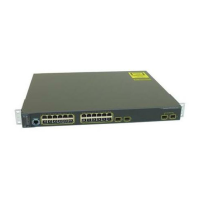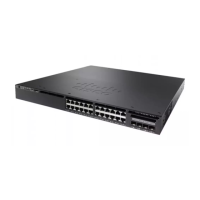PurposeCommand or Action
Enables ECMP multicast load splitting based on source and group address
using the basic S-G-hash algorithm.
ip multicast multipath s-g-hash basic
Example:
Device(config)# ip multicast multipath
s-g-hash basic
Step 3
•
Because this command changes the way an RPF neighbor is
selected, it must be configured consistently on all devices in a
redundant topology to avoid looping.
--Repeat Step 3 on all the devices in a
redundant topology.
Step 4
Exits global configuration mode and returns to privileged EXEC mode.exit
Step 5
Example:
Device(config)# exit
(Optional) Displays the information that IP multicast routing uses to
perform the RPF check.
show ip rpf source-address
[group-address]
Step 6
Example:
Device# show ip rpf 10.1.1.2
•
Use this command to verify RPF selection so as to ensure that IP
multicast traffic is being properly load split.
(Optional) Displays the current state of the IP routing table.
show ip route ip-address
Step 7
Example:
Device# show ip route 10.1.1.2
•
Use this command to verify that there multiple paths available to
a source or RP for ECMP multicast load splitting.
•
For the ip-address argument, enter the IP address of a source to
validate that there are multiple paths available to the source (for
shortest path trees) or the IP address of an RP to validate that there
are multiple paths available to the RP (for shared trees).
Related Topics
ECMP Multicast Load Splitting Based on Source and Group Address Using the Basic S-G-Hash Algorithm,
on page 353
Example Enabling ECMP Multicast Load Splitting Based on Source and Group Address, on page 368
Enabling ECMP Multicast Load Splitting Based on Source Group and Next-Hop Address
Perform this task to enable ECMP multicast load splitting of multicast traffic based on source, group, and
next-hop address (using the next-hop-based S-G-hash algorithm) to take advantage of multiple paths through
the network. The next-hop-based S-G-hash algorithm is predictable because no randomization is used in
calculating the hash value. Unlike the S-hash and basic S-G-hash algorithms, the hash mechanism used by
the next-hop-based S-G-hash algorithm is not subject to polarization.
IP Multicast Routing Configuration Guide, Cisco IOS XE Release 3.6E (Catalyst 3850 Switches)
OL-32598-01 365
IP Multicast Optimization: IP Multicast Load Splitting across Equal-Cost Paths
Enabling ECMP Multicast Load Splitting
